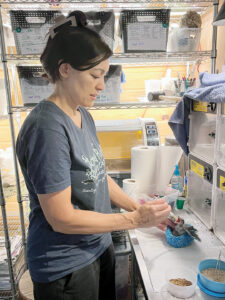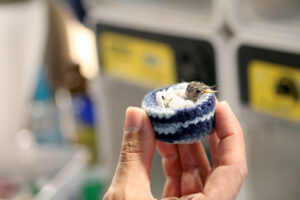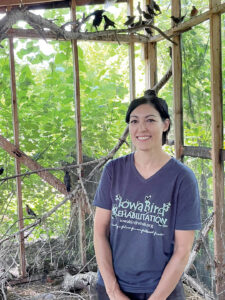Learning to fly…again
9/6/2023In the middle of a Des Moines neighborhood is a bustling place for injured songbirds, sparrows, waterfowl, robins — anything with feathers.
The Iowa Bird Rehabilitation is a nonprofit that takes in injured birds and was established by Jenni Boonjakuakul.
Jenni rehabbed her first baby crow in 1999 in California. Moving to Iowa in 2007, she received a permit to rehabilitate wildlife. In 2017, she and two other volunteers brought in 772 injured birds in the basement of her home. Financially, she could no longer do it on her own and established the nonprofit in 2018.
Each year, the birds rehabbed have doubled. In 2022, they rehabbed 1,819 birds. She says, “All birds are protected by federal law. It’s against the law to take care of wild birds. It’s illegal to tamper or remove an active bird nest.”
Jenni and her team get phone calls or photos of birds that require help. Most are healthy birds that fell out of a nest or involve window collisions or fledglings found in window wells.
“They come in and we determine if they are dehydrated. We wrap a lot of legs and broken wings. We give them time to recover,” she explains.
All types of birds come in from around Iowa. Animal control units from various suburbs also bring in birds. Once birds are evaluated, they are separated from natural bird enemies. With eight different outdoor aviaries, the different sizes allow birds room to flap and test their wings.
 Incubators for tiny birds are in the indoor ICU. Shift volunteers hand feed baby birds every hour for 14 hours a day.
Incubators for tiny birds are in the indoor ICU. Shift volunteers hand feed baby birds every hour for 14 hours a day.
We don’t stay up at night,” she explains. “Birds sleep, too.”
Once birds are on the mend, they are moved to a larger aviary. A special cage is open — and if their wings can make it through the opening, it means they are ready to fly.
Healed birds are released completely into the wild, often at Walnut Woods, Saylorville and other parks. On the other hand, homing pigeons instinctively return to the sanctuary.
If a bird’s quality of life is still viable, but it can’t fly, they will be used as education birds at aviaries, zoos or nature centers in Iowa.
Iowa Bird Rehabilitation is solely based on donations, as well as state grants. Birds eat approximately 50,000 meal worms a week. Fruit, caging and soft-sided crates are vital to prevent further feather damage. Their goal is to have a permanent facility on an acreage outside of Des Moines.
Jenni suggests if people see a bird injured, put it in a box, cover it loosely and call IBR to determine if it’s dehydrated, stunned or needs further care.
 As the goal is to rehabilitate, Jenni and the volunteers try not to get too attached to the birds and avoid naming the feathered friends.
As the goal is to rehabilitate, Jenni and the volunteers try not to get too attached to the birds and avoid naming the feathered friends.
“The release rate is about 60% of the birds who come in will fly out on their own. There’s a lot of death,” she says. “When we do release, it’s very rewarding. This is why we do it.”
For more information, visit www.iowabirdrehab.org. ♦



















